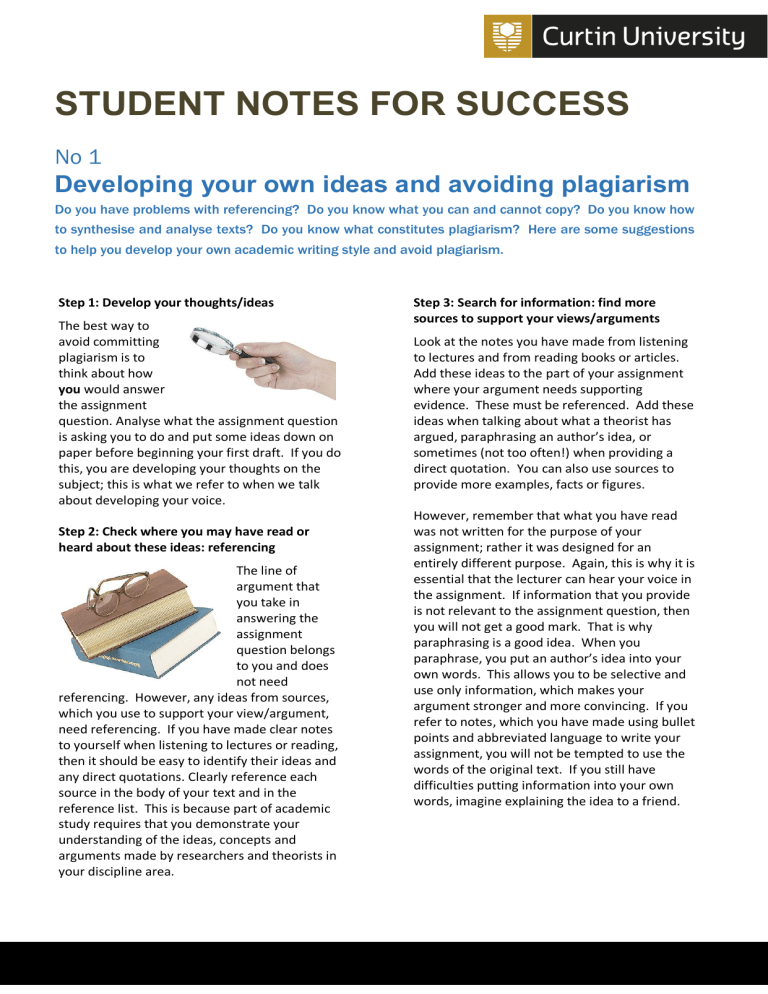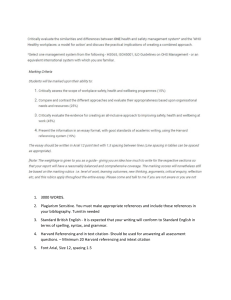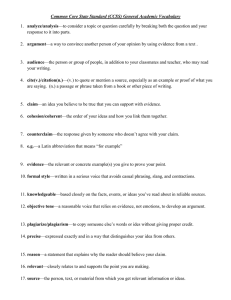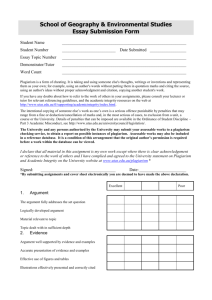
STUDENT NOTES FOR SUCCESS No 1 Developing your own ideas and avoiding plagiarism Do you have problems with referencing? Do you know what you can and cannot copy? Do you know how to synthesise and analyse texts? Do you know what constitutes plagiarism? Here are some suggestions to help you develop your own academic writing style and avoid plagiarism. Step 1: Develop your thoughts/ideas The best way to avoid committing plagiarism is to think about how you would answer the assignment question. Analyse what the assignment question is asking you to do and put some ideas down on paper before beginning your first draft. If you do this, you are developing your thoughts on the subject; this is what we refer to when we talk about developing your voice. Step 2: Check where you may have read or heard about these ideas: referencing The line of argument that you take in answering the assignment question belongs to you and does not need referencing. However, any ideas from sources, which you use to support your view/argument, need referencing. If you have made clear notes to yourself when listening to lectures or reading, then it should be easy to identify their ideas and any direct quotations. Clearly reference each source in the body of your text and in the reference list. This is because part of academic study requires that you demonstrate your understanding of the ideas, concepts and arguments made by researchers and theorists in your discipline area. Step 3: Search for information: find more sources to support your views/arguments Look at the notes you have made from listening to lectures and from reading books or articles. Add these ideas to the part of your assignment where your argument needs supporting evidence. These must be referenced. Add these ideas when talking about what a theorist has argued, paraphrasing an author’s idea, or sometimes (not too often!) when providing a direct quotation. You can also use sources to provide more examples, facts or figures. However, remember that what you have read was not written for the purpose of your assignment; rather it was designed for an entirely different purpose. Again, this is why it is essential that the lecturer can hear your voice in the assignment. If information that you provide is not relevant to the assignment question, then you will not get a good mark. That is why paraphrasing is a good idea. When you paraphrase, you put an author’s idea into your own words. This allows you to be selective and use only information, which makes your argument stronger and more convincing. If you refer to notes, which you have made using bullet points and abbreviated language to write your assignment, you will not be tempted to use the words of the original text. If you still have difficulties putting information into your own words, imagine explaining the idea to a friend. Step 4: Review your drafts (an ongoing process) Once you start to form a structure to your assignment, keep referring back to the assignment question to check that you are staying on track with your ideas. Remember the easiest way to lose marks is failing to answer the question. Carefully analyse the issues that the question is asking you to discuss and refer to information that supports your argument using appropriate referencing. connections between ideas and also the scope of the topic. Note-taking is your opportunity to form an understanding of the text - do not write anything in your notes that you do not understand. Remember that your lecturer wants you to have a view or make a judgment; in expressing this view you need to support it with evidence (i.e. what you have read, facts, figures, examples) and to reference these. Avoid generalisations and instead, talk in possibilities. Examples: Your line of argument What you argue may be restricted by the assignment question. Example “Discuss the advantages and disadvantages for Australia of the Free Trade Agreement” will mean that you need to discuss both the advantages and disadvantages of Australia’s involvement. You will need to mention (and reference!) the relevant ideas of authors which you have learned about through lectures, and reading from other sources. Your lecturer can then tell the difference between your researched ideas, using books and articles, and your own voice. Note-taking skills It is usually helpful to build up an overview of what each author believes. This overview will help you to see where new information you read fits into the bigger picture and to develop your questioning of what you read. For example, you could create a table on a topic and put each author (who has their own theory about this topic) into a column. You can then add some bullet point comments summarising their theories. Again, this is just for your reference, but it helps you to see the It seems that……........ It could be argued that………. Jones (2004) has argued that....and in fact this is supported by several studies including…… By selecting the appropriate words or phrases, you can choose how you use the ideas of others to illustrate your point(s). In other words, your assignment comprises your words, providing the reader with your argument, woven together with the referenced ideas of authors you have read and a few direct quotations where you feel that they add something to the point you are making. A final point to remember: yours is the dominant voice in the construction of your assignment. The work of others is the reinforcement that supports your ideas. Make sure that you are in control. Find out more at the CBS Academic Communication Development website: https://businesslaw.curtin.edu.au/study/studentexperience/academic-communication-development/ You might also be interested in Handy Handout 9. Referencing Ideas. Contact us at: AcademicCommunicationDevelopment@curtin.edu.au





